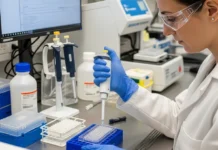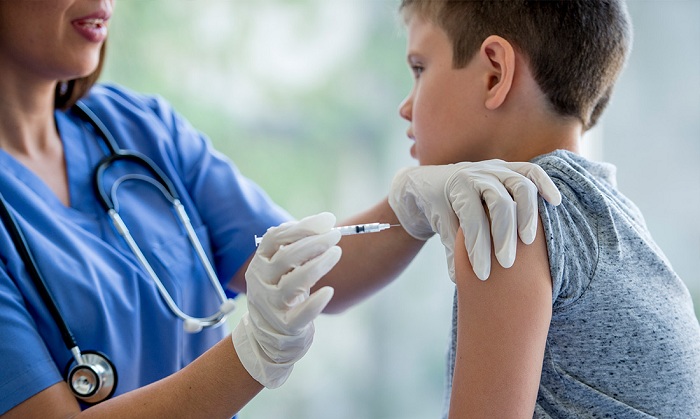Symptoms
People with type 1 or type 2 diabetes may have a range of symptoms. These symptoms might include:
- Frequent urination (polyuria) — often at night (nocturia)
- Excessive thirst (polydipsia)
- Extreme hunger (polyphagia)
- Dry skin
- Weakness/feeling tired much of the time
- Recurring or slow-healing infections
- Weight loss (usually with high blood sugars > 300 mg/dL)
- Blurred vision
- Tingling in the hands or feet
- Nausea/vomiting (often seen in diabetic ketoacidosis in type 1 diabetes)
- Yeast infections
- Skin Infections
- Urinary tract infections
Acanthosis nigricans (in type 2 diabetes; a skin disorder with dark, thick, velvet-textured skin in body folds)
Type 1 diabetes usually occurs in childhood or adolescence. Typical age at diagnosis can range from 5 to 15 years old, although there appears to be an increasing incidence in younger children.
Type 1 diabetes is responsible for roughly 10 percent of all diabetes cases. Insulin treatment is required for all type 1 diabetes patients, as their pancreas has a defect in the beta cells that produce insulin.
Type 2 diabetes accounts for the remaining 90 percent of diabetes cases. The incidence and prevalence of type 2 diabetes has been steadily increasing since the 1950’s. The rise in type 2 diabetes in a direct consequence of obesity, overweight and lack of exercise. The incidence of type 2 diabetes is now increasing in adolescents and young adults, while it used to be a disease that occurred primarily in middle-age and older adults. Insulin resistance and high levels of circulating insulin may occur many years before type 2 diabetes is diagnosed. About 40 percent of type 2 diabetics have no symptoms of their condition, and most patients with diabetes are diagnosed during a routine medical screening. Many patients with type 2 diabetes can take oral diabetes medications, but eventually may need to start on insulin therapy. Patients with type 2 diabetes still have the ability to produce some insulin from the pancreas.
The incidence of type 2 diabetes in children has risen dramatically over the last two decades. According to the Centers for Disease Control and Prevention (CDC), obesity affects 17 percent of all children in the United States, or roughly 12.5 million children – triple the rate from 1980. In general, children with type 2 diabetes are diagnosed at 13 to 14 years of age, coinciding with puberty. Children of certain ethnic groups, including African-American, Hispanic, American Indian, and Asian or Pacific Islander, are at higher risk for childhood obesity. Children with type 2 diabetes run the risk of having serious health-related risks at an early age.
Complications
Research has shown that the complications associated with type 2 diabetes often begin to develop well before the disease is diagnosed. Fifty percent of people found to have type 2 diabetes are already suffering from complications. Microvascular and macrovascular complications, such as retinopathy (eye disease), nephropathy (kidney disease), neuropathy (nervous system disease) and large vessel disease are all a consequence of poor blood sugar control, which may be worsened by weight excess, high blood pressure, smoking, and high cholesterol levels.
Long-term complications of diabetes are more common in people who have poor blood sugar control. The best way to prevent these complications is to maintain tight control over blood sugar levels with regular blood glucose testing. It is also important to have annual eye examinations, foot examinations as well as kidney function tests.
Long-term complications include:
Cardiovascular disease — a major complication and the leading cause of premature death among people with diabetes (about 65 to 75 percent of people with diabetes die from heart disease or stroke). Middle-aged adults with type 2 diabetes are two to four times more likely to die from heart disease than adults without diabetes. Tight glucose control, and use of cholesterol medications like statins, ACE inhibitors, metformin and aspirin may reduce cardiovascular risk in diabetic patients.
Kidney disease — diabetes is a leading cause of renal nephrophathy, which can lead to end-stage renal disease (ESRD). This is a serious condition which may result in the need for dialysis or kidney transplantation. Roughly 40 precent of diabetic patients may develop diabetic nephropathy (kidney disease) without treatment. Diabetic patients are often prescribed ACE inhibitor or angiotensin-II receptor blocker medications to help protect the kidney and control blood pressure if needed.
Blindness — diabetes is a major cause of blindness in the U.S., and is the leading cause of new blindness in working-aged Americans. Diabetic retinopathy alone accounts for at least 12 percent of new cases of blindness each year in the U.S. People with diabetes are 25 times more at risk for blindness than the general population.
Nervous system disease — around 60 to 70 percent of diabetics have some type of nervous system damage or neuropathy, which includes decreased sensation in feet or hands, slowed digestion in the stomach, erectile dysfunction, or carpal tunnel syndrome. Damage to the nerves can ultimately lead to ulceration and amputation of the feet and lower leg. Amputation risk can be lowered by smoking cessation, strict glucose control, management of high blood pressure and lipid levels, and prompt treatment of lower extremity infections.
Dental disease — periodontal or gum diseases are more common among people with diabetes than those without diabetes. Almost one third of people with diabetes have severe periodontal diseases with loss of attachment of the gums to the teeth measuring five 5 millimeters or more. Preventive and routine periodontal care is important for patients with diabetes.
Diabetic ketoacidosis (DKA) — diabetic ketoacidosis is more common in patients with type 1 diabetes, but may still occur in those with type 2 diabetes. DKA occurs due to a lack of insulin, and the body responds by burning fatty acids instead of glucose. The result is a high levels of acidic ketone bodies. Typical signs of DKA include nausea, vomiting, shortness of breath, confusion and possibly coma. DKA is an urgent, possibly fatal, medical condition that requires insulin treatment, fluid replacements and correction of electrolytes.
Hypoglycemia — hypoglycemia (low blood sugar less than 70 mg/dL) may occur in patients who use insulin or take certain oral diabetes medications (sulfonylureas or meglitinides). Symptoms of hypoglycemia may include a fast heart rate, sweating, shakiness, weakness, hunger, and anxiety). Patients with diabetes should know these warning symptoms of hypoglycemia and have glucose tablets or a 20 gram carbohydrate snack on hands at all times to treat low blood sugar. However, in patients who take alpha-glucosidase inhibitors (Precose, acarbose, Glyset, miglitol), an episode of hypoglycemia is best treated with glucose tablets because these drugs will prevent the digestion of polysaccharides often found in carbohydrate-containing foods.
Obstructive sleep apnea — Obstructive sleep apnea is more common in patients who are overweight or obese and has been linked with altered glucose metabolism and insulin resistance.



















